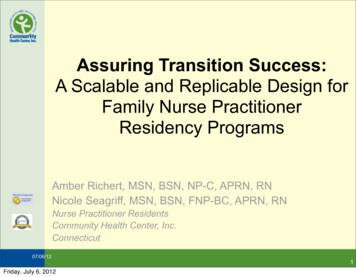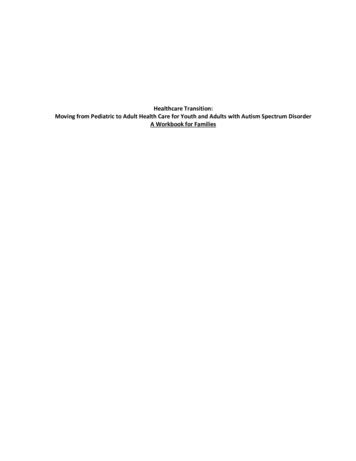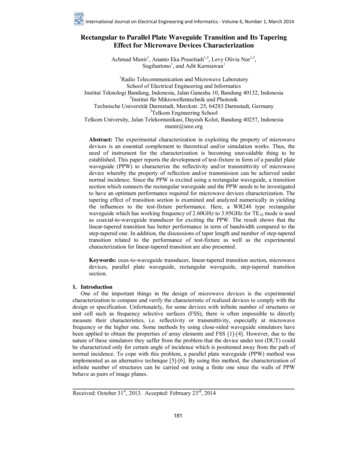
Transcription
Assuring Transition Success:A Scalable and Replicable Design forFamily Nurse PractitionerResidency ProgramsAmber Richert, MSN, BSN, NP-C, APRN, RNNicole Seagriff, MSN, BSN, FNP-BC, APRN, RNNurse Practitioner ResidentsCommunity Health Center, Inc.Connecticut07/06/12Friday, July 6, 20121
Why NP Residency Training? Short- and long-term shortage of primary careproviders for all populations in the US– National Health Service Corps primary care vacanciesincreased 26% in 2011 Literature documents the difficult transition from theacademic setting to practice– Residency is the training bridge from education to practice The 2010 RWJ/IOM Report- Future of Nursing:Leading Change, Advancing Health recommendsresidency training for new APRNs07/06/12Friday, July 6, 20122
Why NP Residency Training? Patient Protection and Affordable Care Act (PPACA) calls forincreasing the number of patients served in FQHCs from 20 millionto 40 million. Section 5316 of the PPACA authorizes a demonstration project toreplicate the NP residency model. NPs are ideally suited forFQHC practice as primarycare providers:– Focus on prevention– Comprehensive care– Holistic approach07/06/12Friday, July 6, 20123
Why NP Residency Training? Nurse practitioners (NPs) have not effectively sought, and have notreceived, an investment of training resources consistent with thedemands and expectations of practice as primary care providers.New NPs have not had the option of choosing a formal residency inprimary care, nor have organizations who sought to provide such traininghad access to funding for it.Fellowships have emerged as a way totrainnew nurse practitioners in specialtyand subspecialty care such as HIV/AIDSandhospitalist care, pulling new NPs awayfromprimary care.March 23, 2010: President Obama signedcomprehensive health reform, the PatientProtection and Affordable Care Act,authorizing a demonstration project toreplicate the family nurse practitionerresidency training program in federallyqualifiedhealth centers (FQHCs) andnurse managed healthcenters that have the size,scope, andsophistication to undertakesuch a program.Flinter, 201007/06/12Friday, July 6, 20124
Community Health Center, Inc.CHC VisionSince 1972, Community Health Center, Inc. has been building a world-classprimary health care system committed to caring for underserved and uninsuredpopulations and focused on improving health outcomes, as well as building healthycommunities.CHC Inc. Profile Founding Year - 1972Primary Care Hubs – 13No. of Service Locations - 218Licensed SBHC locations – 24Organization Staff - 560Innovations 07/06/12Friday, July 6, 2012Integrated primary care disciplinesFully integrated EHRPatient portal and HIEExtensive school-based care system“Wherever You Are” Health CareCentering Pregnancy modelResidency training for nurse practitionersNew residency training for psychologistsThree Foundational PillarsClinical ExcellenceResearch & DevelopmentTraining the Next Generation5
CHC NP Residency Model 12 months, full time employment at CHC, Inc.Clear learning objectives and evaluation planContinuous training to the CHC model of high performance health system: access, continuity,planned care, team-based, prevention focused, use of electronic technologyResidents participate in on-call and weekend rotations, clinical committees and task forces4 core elements: Precepted “continuity clinic” Specialty rotations Independent clinic Didactic educationDefinitions: Continuity clinic: the resident builds a panel of patients with support from expert CHC NP and MDpreceptors Specialty rotation: the resident participates in specialty care practices within and outside of CHC inorthopedics, women’s health/prenatal care, adult and child psychiatry, geriatrics, healthcare for the homeless,HIV care Independent clinic: an opportunity to practice with less supervision and more autonomy, the residents seepatients delegated to them by another provider Didactic education: weekly lectures and presentations on high volume/high risk problems07/06/12Friday, July 6, 20126
NP Residency Program Expansion2007 Middletown, CTCommunity Health Center, Inc. establishesthe first NP Residency (4 residents)2009 Worcester, MAFamily Health Center of Worcester (22011 residents)Philadelphia, PAPuentes de Salud (1 resident)Austin, TXCommUnityCare and University of Texas,Austin School of Nursing (2 residents)Bangor, MEPenobscot Community Health Care (22012 residents)Los Angeles, CAUnion Rescue Mission Health Center andUCLA (2 residents)San Francisco, CAGlide Health Services and UCSF School ofNursing (2 Residents)Santa Rosa, CASanta Rosa Community Health Centers (4residents)Tacoma, WACommunity Health Care (4 residents)07/06/12Friday, July 6, 20127
Assessing Progress A survey was conducted of the eight organizationswho have launched NP residency programs usingCHC’s model Respondents provided data regarding programconstruct, features, strengths, challenges andconstraints– For most programs, these are very preliminary impressionsas the residencies are still in their formative stages Follow-up interviews were conducted to assureunderstanding and gather additional details07/06/12Friday, July 6, 20128
NP Residency Program ReplicabilityCHC ModelDidactic EducationIndependentClinicsxPrecepted ContinuityClinicsxSpecialty rxxxxLos AngelesxxxSan FranciscoxxSanta RosaxxxxTacomaxxxx100%62.5%100%88%Data provided by NP Residency Program Coordinators All residency programs are twelve months in length All comprise elements of a precepted clinical experience anddidactic education All include some form of orientation07/06/12Friday, July 6, 20129
New NP Residency Programs: Features Admissions/Selection Committee Commitment to interprofessional education and training Didactic sessions organized to give priority to topics thatwill be used earlier or more often Didactic sessions delivered to both NP and medicalresidents Elective rotations including inpatient rounding, call andresident-specific areas of interest Exchange rotations with partner NP Residency Programs Faculty support through the local University Integration with Medical and Dental residencies for fullinter-professional training Leadership building Meetings with psychologist regarding transition into role/community health Participate in hospital rotations and community events Resident support through journaling on line “moodle” Resident designed projectData provided by NP Residency Program Coordinators07/06/12Friday, July 6, 201210
New NP Residency Programs: DifferencesAdditional DidacticsCultural competence (rural)Legal issues in primary careLipid managementMedical marijuana useObstetrical care in primary carePatient abuse and neglectPublications and otherprofessional endeavors Splinting workshop Data provided by NP Residency Program Coordinators07/06/12Friday, July 6, 201211
New NP Residency Programs: DifferencesAdditional Specialty RotationsAcupunctureAcute and gyInternal medicineNeurologyNutritionOccupational HealthOphthalmologyPharmacyPodiatryProcedures ClinicPsychotropicmedicationmanagementUrgent careData provided by NP Residency Program Coordinators07/06/12Friday, July 6, 201212
New NP Residency Programs: Differences Orientation ranges from one to two weeks– CHC orientation is four weeks– One residency reports its orientation is six weeks Number of residents ranges from one to four– Four of the programs have two residents Programmatic terminology across the programs isinconsistent Some programs intend to retain residents as PCPsafter program completionData provided by NP Residency Program Coordinators07/06/12Friday, July 6, 201213
New NP Residency Programs:Early Challenges and Constraints Adequate clinical spaceFull engagement of organizationImpact on productivity goalsState-specific laws limiting prescriptiveauthority of residents Differentiating the role of students andresidents Adequate support staff Sustainable funding model07/06/12Friday, July 6, 201214
New NP Residency Programs: Common Funding is an important factor and frequentchallenge– Solutions have included public and private grant funding aswell as partnering with medical and dental residencies Growing interest has increased demand forresidency programs– Some programs are increasing their capacity for NPresidents07/06/12Friday, July 6, 201215
Recommendations Successful implementation requires more than acommitment to training the next generation of FCHCPCPs– Residency programs require stable clinical and financialscaffolding Expansion will benefit from consistency and supportacross all programs– CHC’s Weitzman Center is well suited to serve as acentralized hub for NP Residency Programs07/06/12Friday, July 6, 201216
For More Information Amber RichertFamily Nurse Practitioner Residentrichera@chc1.comNicole SeagriffFamily Nurse Practitioner Residentseagrin@chc1.comKerry BamrickNurse Practitioner Residency Program Coordinatorkerry@chc1.comMargaret FlinterSenior Vice President and Clinical Directormargaret@chc1.comCHC Website: www.chc1.comCHC NP Residency: www.npresidency.com07/06/12Friday, July 6, 201217
Family Nurse Practitioner Residency Programs Amber Richert, MSN, BSN, NP-C, APRN, RN . BSN, FNP-BC, APRN, RN Nurse Practitioner Residents Community Health Center, Inc. Connecticut 1 Friday, July 6, 2012. 07/06/12 Why NP Residency Training? Short- and long-term shortage of primary care . UCLA (2 residents) San Francisco, CA Glide Health .











